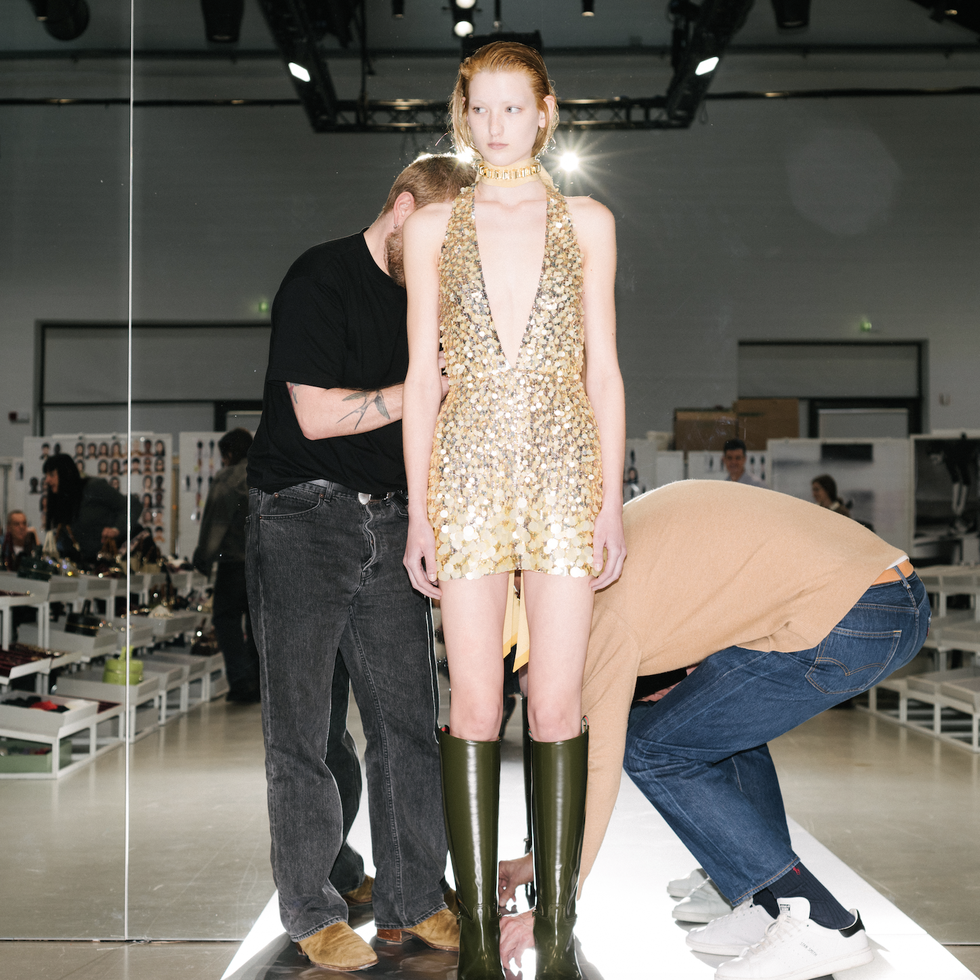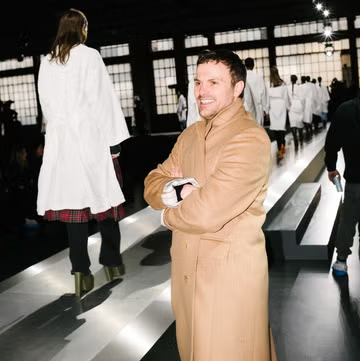It is five hours before Sabato De Sarno will show his second collection for Gucci. At the show space in Milan, there is a marked lack of the frenetic chaos that typically fills the hours leading up to a runway show: The music sounds great, the bare runway looks sharp, and the models who have started to arrive seem genuinely blissed out to be there. So does the Gucci team: No one has anxious faces, nor is anyone panic-steaming the clothes.
De Sarno walks through the space, and it is instantly clear that this uncharacteristically levelheaded fashion scene vibe is his doing. He smiles and says “Ciao!” to nearly every single person he passes, doling out lots of hugs, rather than terse nods or double kisses.
 Federico Ciamei
Federico Ciamei
Advertisement – Continue Reading Below
De Sarno talks about his Fall 2024 collection with great reverence for the many, many people who helped create it. “To have conversations with all of the people I work with is always inspiring to me,” he says. “To learn different points of view from some of the people who’ve been with Gucci for decades—it’s important. The past and the experiences of these people is important.” He mentions one woman in particular, who has been with the company for over 40 years working in shoe design, saying she is instrumental in making sure that whatever he gleans from the archive is updated and evolved into something worthy of today’s customer. Case in point: the new Gucci tall riding boot, made in a buttery-soft leather and embellished with the horsebit hardware at the heel. Some of the models backstage have slipped them on already, talking about how much they love them and how comfortable they are.
 Federico Ciamei
Federico Ciamei
Moving through the racks of looks with De Sarno provides insight into just how much he means it when he says he’s “a designer” in the technical sense, and someone who keeps his attention on “product and process.” He looks delighted scanning a sheer lace slipdress decorated in clear, almost unnoticeable water-droplike paillettes, and running his hands down the exacting seams on one of his now-signature overcoats—some of which are made with adjustable, hidden buttons at the back so they can be undone and worn more loose, depending on the wearer’s shape and preference. He honed in on knits this season a bit, too, with pretty, fitted bouclé jumpers. The workmanship is all quite exquisite up close, especially the zigzagged patchwork snakeskin on a leather jacket, and the corset and cut of a strapless wool column dress. The fall collection is a natural evolution of his debut, one that still leans a bit toward a younger customer but has the potential to expand beyond the women who will want those spectacular slips and spicy leather shorts.
Advertisement – Continue Reading Below
 Federico Ciamei
Federico Ciamei
I mention to De Sarno that it feels not like a collection preview, but almost more like a shopping trip to peruse covetable clothes. “The real fashion show for me is in the store,” he says excitedly. “When the collection arrives in the stores, and people can go very close to the clothes and see the details and try them and fall in love with the pieces, that’s what luxury means.”
 Federico Ciamei
Federico Ciamei
When De Sarno started at Gucci nearly seven months ago, he was tasked with a nearly impossible assignment: to steer the brand away from its former creative director’s bold, outsize, magpie aesthetic to something more relatable, more appealing. De Sarno says he cares deeply about dressing real human beings for their very real lives. “I start with people, always,” he says. He is uninterested in making clothes for people to take selfies in (though there are plenty of Instagrammable pieces in the current collection), or in pleasing a small, insular group within the industry whose opinions, ultimately, won’t have any bearing on, say, a woman in the Midwest walking into a Gucci store and falling in love with a perfectly tailored double-breasted jacket.
Advertisement – Continue Reading Below
I tell De Sarno that my mom visited her local Gucci store in Chicago the other day, just to check out some of the changes that have been made. She loved how “sleek” it all looked, from the interiors to the window displays to the bags and the clothes themselves, I say. “To be honest, I care more about the opinion of your mother than I do some of the technical people’s opinions in the industry,” he replies with a smile. “Also, you can’t imagine how many messages I receive from young students or from everyday, normal people who don’t work in fashion, saying how much they appreciate the new collections, how real the pieces feel, and how they went to a store and tried on a coat and they fell in love with it. This, to me, is fashion.”
 Federico Ciamei
Federico Ciamei


